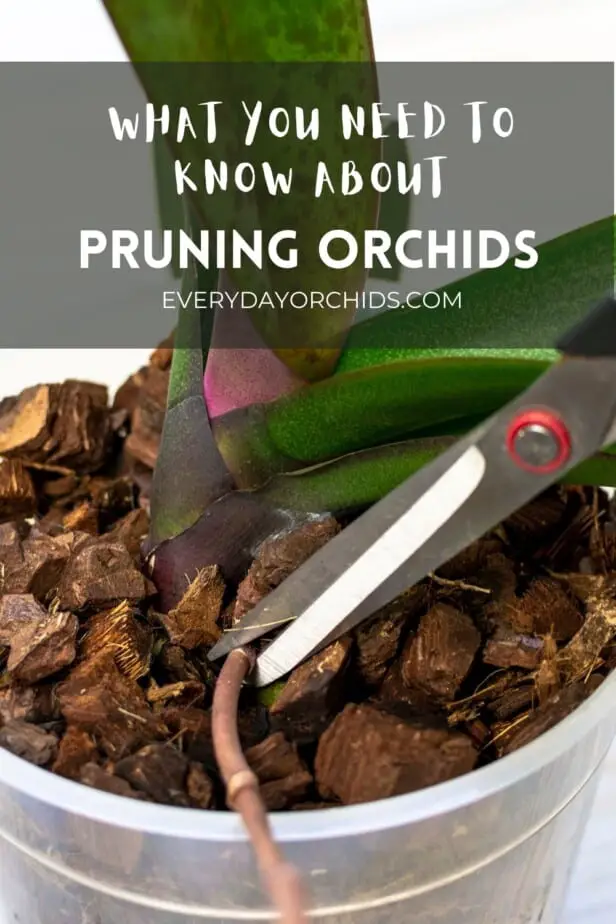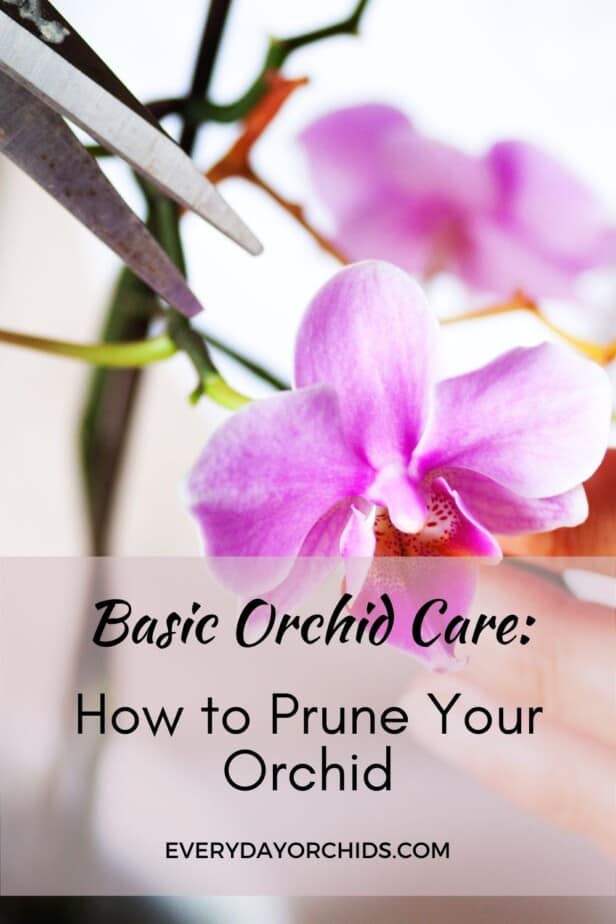Most types of plants require routine pruning to keep them looking neat and tidy, and this includes orchids. Pruning has a more important purpose: to promote plant health. Cutting away the unwanted or dead parts of your plant will encourage healthier and more productive growth. Pruning orchids is an important part of routine orchid care, but the question is, how do you prune an orchid plant? I will go over that below, so stick around.
You need to prune orchids to get rid of old, diseased, or dead tissues to make room for new growth. Pruning is an essential part of orchid care, especially after the orchids have bloomed. Keep in mind that different varieties of orchids will require different pruning methods. When pruning your orchid, use sterilized scissors or gardening shears to prevent the spread of infection or disease.
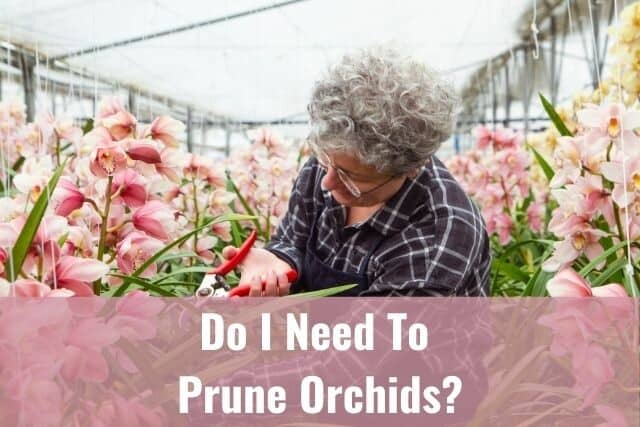
In this article, I’ll go over the general benefits of pruning your plants. You’ll also learn about what pruning can do for your orchids and what will happen if you do not prune them. In addition, you’ll get tips on how you can correctly prune your orchids.
Please note that these links are affiliate links and as an Amazon Associate, I earn from qualifying purchases. Purchases made through affiliate links in this post may generate commissions at no additional cost to you. Use this link for a discounted Amazon Prime trial. Thank you for your support!
Table of Contents
First Things First: What Is Pruning?
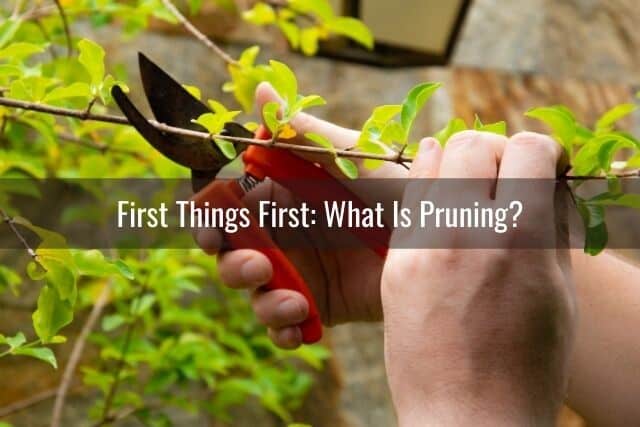
Pruning is a gardening or horticultural practice where you selectively cut off unwanted branches from a plant. Doing this helps improve the structure of the plant or tree. Routine pruning makes the density of leaves and branches manageable and directs the growth of new and healthy branches.
Why Is Pruning Important?
Pruning is important for plants for aesthetic, practical, and health reasons. Plants, especially shrubs and trees, will look more well-tended and structured when they are pruned.
For trees, trimming branches helps ensure that they do not become a safety risk. If branches grow heavily on one side and lean in a particular direction, they could eventually break, especially when a strong wind blows. The density of overgrown limbs and branches may also block the sunlight for smaller plants. Regular pruning allows you to manage your plant’s size and height and reduce the reach of branches before it gets out of control and becomes a problem.
Pruning Helps Plants Thrive
Pruning also promotes more fruitful growth for your plant. Crossed, diseased, or damaged branches can cause stress in your plant. Pruning also improves the airflow through the plant. This encourages better branch and leaf distribution. As a result, your plant becomes healthier and stronger. You can read more about basic pruning here.
Why Should You Prune Orchids?
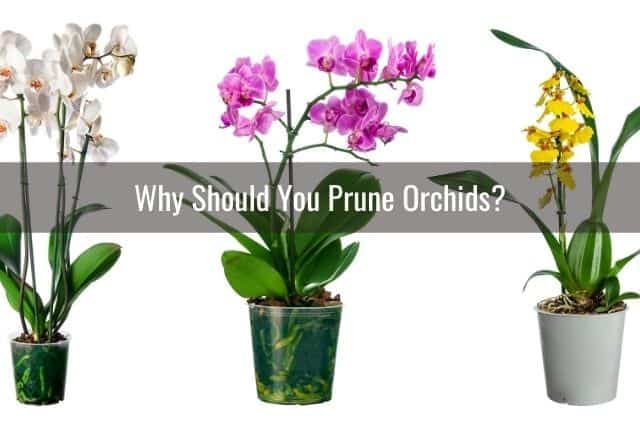
Plants, especially shrubs and trees, need pruning for healthier growth. But do you need to prune your orchids too? The answer is yes.
Orchids need pruning, or trimming, for the same fundamental reasons: their health. Pruning your orchid can help it live longer and produce better blooms. It is also necessary to remove dead leaves and other dead plant materials. If left on the plant, the decaying plant matter would provide a home for pests, fungi, bacteria, and mold. Pruning your orchid also gives you a chance to inspect it more closely and spot problems early on.
When Should You Prune Orchids?
The best time to prune your orchids is after the blooming season, once the flowers have all fallen off. When the plant is done blooming, this signals the beginning of the orchid’s dormancy period.
Doing some major pruning when your orchid is dormant is less stressful for the plant. During dormancy, the plant is focused on storing its energy for new growth and preparing for the next blooming season.
Pruning is also recommended right before repotting your orchid. As always, pruning and repotting are best done when your plant is dormant. The exception to this would be a situation such as root rot or disease, when you would need to prune or repot immediately.
How Often Should You Prune Your Orchids?
Orchids generally do not need to be pruned as frequently as other plants. Typically, you would need to prune your orchid only as often as it blooms. Most orchid varieties bloom only once a year, so a yearly trimming would suffice. More frequent pruning would be needed for species that bloom more frequently. This is true even if you just end up simply trim off dead spikes and remove spent blooms.
How Do You Prune Orchids?
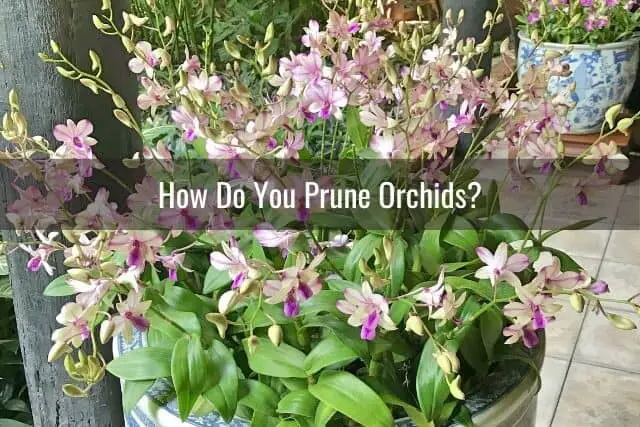
Orchids have different needs and growing specifications than most other house plants. Naturally, the way you would prune your orchids would be different too. You probably already know this, but unlike with your other plants, you cannot just cut off parts that you feel are growing too tall or are getting in the way.
It is essential that you learn the proper way to prune your orchid before you start. It would help to also know how to prune specific types of orchids. Different orchid species may require different pruning methods.
Sterilize Your Pruning Tools
Pruning your orchid should always start with sterilizing your pruning shears or scissors. Contaminated sap, soil, and other debris may have gotten stuck to your shears during the previous pruning job. Sterilization helps to ensure that pathogens like mold, fungi, or bacteria that might have been left on your shears are killed and do not infect your orchid. The plants you had pruned previously may carry these pathogens even if they do not show signs of any disease.
How To Sterilize Your Pruning Shears
You can dip the blades of your pruning shears or scissors in a jar or cup of 70% isopropyl alcohol or disinfectant. Follow the steps below to sterilize your gardening tools:
- Soak your gardening tools in a container of 70% isopropyl alcohol or disinfectant for 30 seconds to 1 minute.
- Open and close the scissors several times to allow the alcohol to reach all parts of the blade, especially the crevices.
- Take out the shears from the jar or cup and dry them on a paper towel. Alcohol dries rather quickly, so you only need to wait for a few minutes before they are fully dried and ready for use.
Alternatively, you can also make and use a 10% bleach solution to disinfect your gardening tools. This would actually be a better option if you are planning to repot your orchid and also have orchid pots or other items you want to sterilize. If that is the case, you can make a bucket of the 10% bleach solution and soak your orchid pots and gardening tools all at once. Do this the day before you plan to repot your orchids.
- In a well-ventilated area, dilute 1 part bleach with 9 parts water in a large bucket or container.
- Place your gardening tools inside the 10% bleach solution and soak them for around 30 minutes.
- Afterwards, rinse your shears (and orchid pots and other items you were sterilizing) and allow them to air dry before using.
One problem with the 10% bleach solution method is that bleach gives off harmful fumes that may be irritating to some. In order to minimize this, make sure you do this in a well-ventilated space, preferably outdoors. Protect your skin by wearing cleaning gloves when coming into contact with the bleach solution.
Make Sure Your Pruning Tools Are Sharp and Well-Lubricated
It is important to use sharp and well-oiled garden shears or scissors for pruning your orchids and your other plants for that matter. Sharp blades make cleaner cuts on your plants and these will heal better and faster.
Dull, coarse, and rusty blades will not be able to remove unwanted stems and branches in one snip. You may need to make several attempts at cutting through tough fibers. A ragged, uneven cut would allow bacteria and pathogens to more easily invade and infect your plants.
Coating your shear blades with silicone-based lubricant will help repel water and prevent oxidation and rust. It will keep dirt and sticky sap from drying on the blades and damaging your shears.
Remove Flower Spikes, Dead Stems, and Dead Roots
The right timing is crucial for pruning your orchids. Generally, you will need to wait for all of the flowers to fall off the spike and for your orchid’s blooming period to end before you start pruning.
The length of an orchid’s blooming period can vary depending on the type of orchid you have. Phalaenopsis flowers, for example, can last an average of one to four months. Cattleya flowers can last one to four weeks.
The way you prune your orchid will vary depending on the reasons for pruning. For instance, pruning may be different if you are doing it as a routine step as part of repotting your plant or if you are removing rotted roots and stems due to disease or infection. It may also be different if you are pruning in order to encourage flowering. You will also need to take into consideration orchid species or varieties.
Should You Prune Orchid Stems After They Bloom?
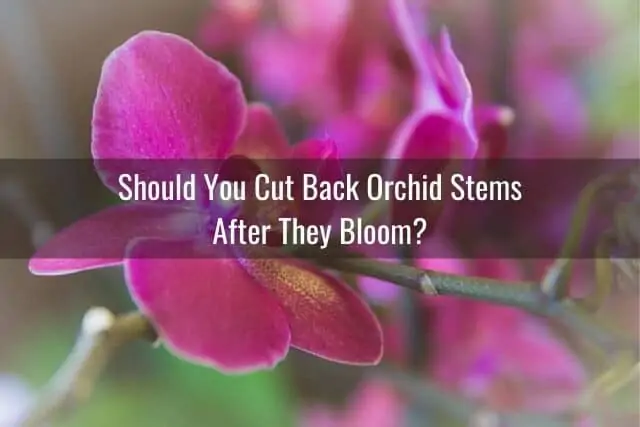
After your orchid has finished blooming and the flowers have dropped from the flower spike or stem, you have three options:
- Leave the flower stem or flower spike intact.
- Cut the flower spike back to a node.
- Remove the flower spike entirely.
Where do you cut an orchid stem after the flowers fall? Let’s go over that. It really depends on the situation and I will go over different scenarios below.
When To Leave the Flower Stem Intact
You can leave the flower stem or spike intact if you feel like there is a chance a new spike can form from one of the remaining nodes. Sometimes, this happens. In fact, there are ways you can prune your orchid to make it to rebloom.
However, a flower spike that is too long and top-heavy might look out-of-balance and put stress on the plant. Some orchid growers will choose to prune this spike back to a more manageable length.
When To Cut the Flower Stem Back to a Node
Cutting the flower stem or spike back a node or a couple of nodes down from the last bloom can help encourage your orchid to rebloom. To do this, trim your orchid about 1 inch below the spot of the lowest bloom. This will encourage your orchid to produce new flower stems or flower spikes from that lower node.
Check to see if your plant has dormant eyes on the nodes of its flower stem. A node is the thick, brownish line that runs horizontally all around the flower stem. The dormant eyes look like tiny triangles covered with a thin brown or beige-colored sheath. These can become new flower stems later on.
Keikis or baby orchids can grow from these nodes, too. So, if you see an eye on a node, cut just above it. Prune around half an inch to an inch above the node. Cutting too far away from the node or too close to it may affect the plant’s ability to flower.
When To Remove the Flower Spike Entirely
Removing the flower stem or spike completely is the best option if it starts to turn yellow or brown. This yellow or brown color means that the flower stem or spike has died and will no longer produce flowers.
It is best to remove these from the orchid plant. Doing so will allow the plant to direct its energy towards growing new roots or leaves. This will, in turn, help the orchid become healthier and prepare for the next batch of flowers.
You can also do this if your orchid has already flowered multiple times and you feel like it needs to rest, even if the spike is still green. If you choose to do this, cut the spike off at the base of your plant or to the level of the potting media.
After cutting the stem or spike, always apply some ground cinnamon powder to the open cut area to prevent infections from occurring. Cinnamon powder has antifungal properties. It is inexpensive and easy to obtain from any grocery store. Ground cinnamon also has a drying effect, which will help seal off the area and keep the plant healthy.
Should You Prune Dead Orchid Stems?
Yes, you should cut off dead orchid stems. You should also cut off any part of the stem that is dead, as you would with any other dead parts of any plant.
However, stems in orchids can be confusing. It can refer to a flower stem or flower spike, it can refer to the main stem of a monopodial orchid like Phalaenopsis or Vanda, or it could mean one of the pseudobulbs of a sympodial orchid like a Dendrobium. It can get confusing!
Whatever stem you are referring to, it is always best to remove it or remove the part that is dead. You will know it is dead because it will appear brown, dried out, and shriveled. Meanwhile, a stem that has died due to rot will be mushy and soft. Rotted parts of your orchid should be pruned off as well.
Removing the dead or rotted parts is important for maintaining your orchid’s health. Leaving these on your orchid could introduce opportunities for infection or for the rot to spread, especially if these are the reasons why that section of your orchid has died.
Sometimes the orchid spike has broken off part way, requiring you to further cut it back. If you are interested in learning more about what to do in that scenario, check out this article about various problems you might encounter with your orchid spike. There, you will learn what you can do to deal with a broken orchid spike.
Pruning could be quite tricky with monopodial orchids because they only have one main stem. Cutting a dead stem could mean there would be no more roots left or no more leaves left, depending on which part of the stem still has live tissues. Either way, it is still possible to save your monopodial orchid even without roots or without leaves. I go in detail in another article about what you can do to save your orchid if it has lost all its roots.
Will the Orchid Grow Back After You Prune It?
Yes and no. You would typically only prune or cut off dead parts of your orchid, such as dead leaves, roots, and stems, and these will not grow back. However, new growths will appear in nearby areas where there are still live tissues. So yes, your orchid will experience growth after pruning, but not from the specific areas that have been pruned off.
Pruning Your Orchid Before Repotting
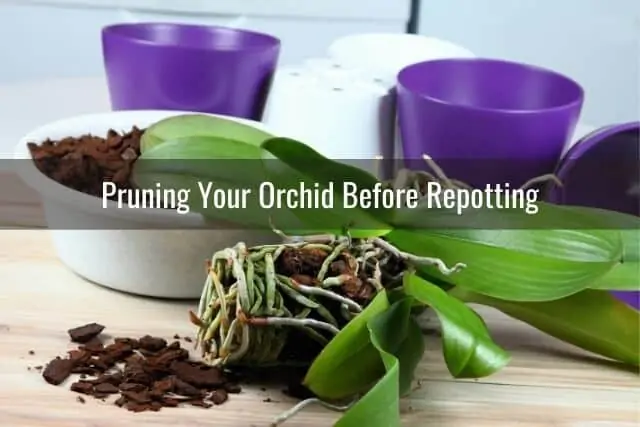
Orchids that are thriving and growing will eventually outgrow their current pots. When this happens, you will need to repot your orchid into a slightly bigger orchid pot to make room for growing root systems. When you are getting your orchid ready for repotting, a majority of pruning occurs in the roots.
It is common for some of the roots to rot and die over time due to the cramped space inside the pot. Orchids, especially epiphyte orchids, need good air circulation around the roots. The bigger the root system gets, the less space there is left for air to flow in the pot.
Moreover, extensive root systems could lead to blocked drainage holes in the pot. This could lead to slower drainage and increased moisture in the potting media.
Here is how you can prune your orchid in preparation for repotting:
- Gently remove your orchid from its current pot.
- Carefully remove the potting media. You can use a stick to dislodge parts of the potting media that are stuck in tight spaces within the network of roots. Alternatively, you can place the orchid roots in a bucket of water and gently dislodge the potting media from the roots.
- Rinse the roots with running water and make sure all the old potting media’s remaining debris has been washed away.
- Using your sterilized pruning shears, cut off any roots that have dried out or shriveled. Cut off any rotted roots that are black or brown, mushy or soft. Be careful to not accidentally snip off healthy roots or aerial roots.
- Apply an anti-fungal powder for orchids, such as ground cinnamon, to any cut root ends.
- Cut off dead leaves if there are any.
- Plant your orchid in a clean pot using fresh new potting media.
Pruning Different Types of Orchids to Encourage More Flowers
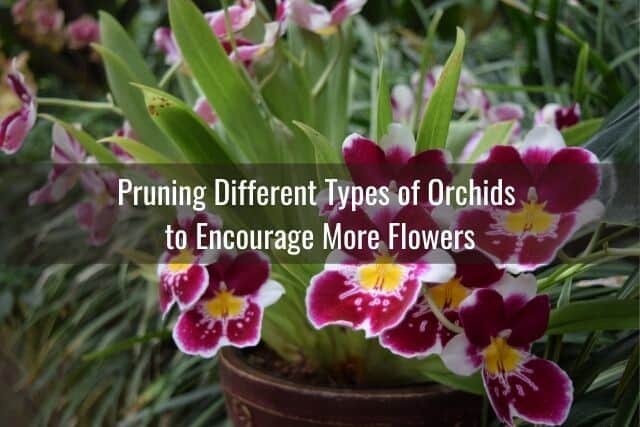
You can prune your orchids to encourage flowering, but the process would depend on the orchid species.
For instance, with Phalaenopsis orchids, you can cut off the fading flowers and prune down the flower spike. This will encourage new flower stems to form along the node. By doing this, you can extend your orchid’s flowering phase and trigger another round of blooming.
The flower spike will eventually wither once the plant has spent its energy flowering. When this happens, you can cut off the spike entirely so the plant can rest and start storing energy for the next flowering season.
Things may be different with Dendrobium orchids, though. You can cut off the flowers as they fade or wilt, but it is best to leave the canes or stems alone. Flowers may still form on the old canes the following year, even if they look dry. Besides, old canes or stems store water and nutrients that may help sustain the new ones.
After-Pruning Orchid Care
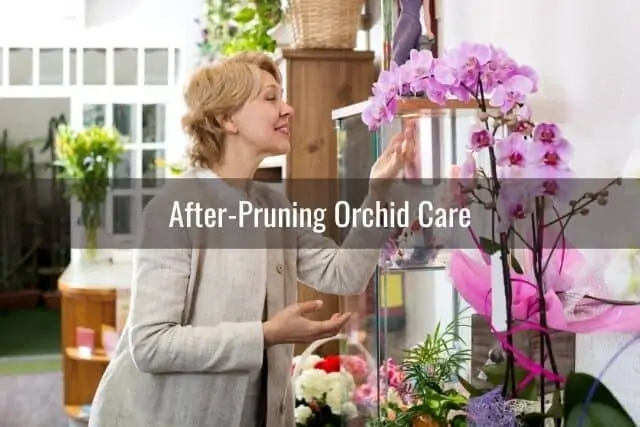
Keep in mind that pruning your orchid can leave it vulnerable to disease or stress. That is why it is best to prune your orchid during its dormant phase and not during its active growing phase.
After pruning, you may want to take certain steps to ensure that your orchids continue to grow in optimal conditions. Here is how you can do that:
Apply Some Cinnamon Powder on the Freshly Pruned Area
Ground cinnamon is a very effective anti-fungal for orchids. This is the same ground cinnamon powder that you can buy in the baking area of your grocery store. Not only is it inexpensive and easy to find, but it is an effective anti-fungal when applied to cut or infected areas of your orchid plant.
If you have pruned parts of your orchid’s leaves and stems due to a fungal or bacterial infection, you can apply some cinnamon powder on the wound of the freshly pruned parts. You can also do so as a precautionary measure after pruning or even if your orchid is not infected with any disease. This common kitchen item is said to have natural anti-fungal properties. It is not harmful to your plant if used properly.
However, if you are doubtful about the anti-fungal effects of cinnamon and would rather use a commercial fungicidal product, that is fine as well.
You can use cinnamon powder after pruning, but for a different yet more important purpose: as a sealant. Cinnamon is an effective drying agent and can help seal a cut wound quickly.
As such, cinnamon can be applied on live tissue to promote drying, sterilize the wound, and help prevent reinfection. If you pruned an already dried out stem and the cut area has no more live tissues left, then applying cinnamon is no longer necessary.
To apply cinnamon, make sure that the cut area on the orchid is still moist so that the powder will stick and not fall off. You can use a Q-tip or your clean fingers to apply the cinnamon powder.
However, when applying ground cinnamon to cut roots, you want to make sure you do not apply excessive amounts. Excess ground cinnamon would fall off into the potting media and dehydrate and damage the root system.
Give Your Newly Pruned Orchid the Best Lighting
Place your plant near a window where it can receive bright yet indirect sunlight. Orchids that do not get the right amount of light will not have healthy roots and leaves. If this happens, you would only need to do even more pruning because you will end up with more dried up and shriveled roots and dehydrated leaves. Inadequate lighting will also stress your plant. This in turn, will affect its blooming.
If your home does not have great natural lighting, you may need to supplement with some artificial lighting. You can read more about how to set up artificial lighting for orchids here.
Give Your Orchid Enough Water and Do It Carefully
Water your orchid thoroughly once its potting medium has dried. When watering, make sure you water the roots and potting media. Take care not to get the leaves or crown wet. If you get them wet, immediately dry the leaves and orchid crown with a paper towel. Avoid letting water sit in the orchid crown, since this will cause crown rot.
If you are repotting your orchid, use a well-draining orchid pot with an airy potting medium. Place the potting media loosely in the pot around the roots in order to allow air to circulate around the root system and allow water to drain and evaporate quickly. This way, you can avoid root rot, and you will allow your plant to grow healthy new roots more quickly.
Final Thoughts
Pruning is as essential for orchids as it is for most other plants. Getting rid of dried out, diseased, or dead leaves, stems, canes, flower spikes, and roots can help lessen the orchid’s stress and promote new growth.
If you are doing routine pruning for your orchid, it is best to prune after your orchid’s flowering period or during dormancy. Make sure you know how to prune your particular orchid species as well. This will help ensure you have success with pruning your orchids.
If you enjoyed this article, please pin it and share!
